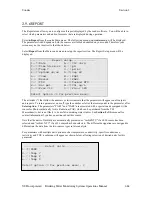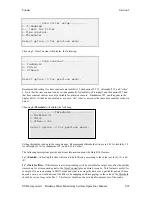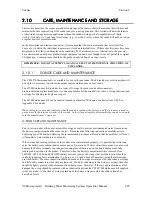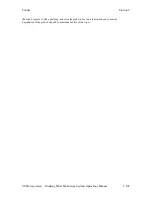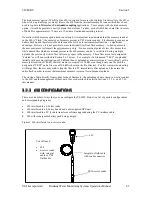
Sondes
Section
2
YSI Incorporated
Drinking Water Monitoring Systems Operations Manual
2-94
3-Time Constant.
This value is the time constant in seconds for the software data filter. Increasing the
time constant will result in greater filtering of the data, but will also slow down the apparent response of the
sensors.
4-Threshold.
This value determines when the software data filter will engage/disengage. When the
difference between two consecutive unfiltered readings is larger than the threshold, then the reading is
displayed unfiltered. When the difference between two consecutive readings drops below the threshold,
readings will be filtered again. For the purposes of the filter, consecutive readings are never more than 0.5
seconds apart. When sampling faster than 0.5 seconds consecutive readings will be at the faster rate and
you may want to adjust the threshold accordingly. See section 2.9.1 for details on fast sampling.
The threshold feature is intended to speed response to large changes in a reading. For example, when
changing from pH 7 buffer to a pH 4 buffer in a calibration, it is likely that the filter will disengage for a
time showing unfiltered readings until the sensor has nearly equilibrated with the new buffer. At that time,
the filter will re-engage and show filtered readings. Without disengaging the filter for awhile, much more
time would be required to come to equilibrium after large changes in reading.
During the first time constant after the filter first engages, the output reflects a simple average of all the
readings from the time the filter engaged until the present. Once the filter has been engaged for the period
of the time constant, it becomes a simple filter with a time constant equal to that set in
3-Time Constant
.
Each time the filter disengages and then re-engages, this process is repeated.
Filter engagement and disengagement occurs for each sensor independently. One parameter may be filtered
while another is not because readings from one sensor are changing more than another.
Example: Moving a sonde from the air to a river water sample. Assume that the temperature of the sonde is
similar to the temperature of the water, and that the water is in equilibrium with the air. The temperature
and oxygen readings taken in the water will be very similar to those taken in the air. The conductivity
reading in air is near zero, and quite likely, is a very different reading in the water. The filter for the
conductivity readings will likely disengage when the sonde is first placed in the river water, but stay
engaged for the temperature and free chlorine readings.
The filters for turbidity, chlorophyll, and rhodamine WT are somewhat different. For these sensors, the
filter is temporarily disengaged during mechanical wiping so that when wiping is finished, the reading is
the most current. The filter then reengages if possible. Optical sensor readings are frozen to the output
during wiping so that “bad” values are not output.
A value of 0.001 for the threshold roughly corresponds to the following changes in sensor readings:
Temp: 0.1 °C
Conductivity in the 100 mS/cm range: 0.1 ms/cm
Conductivity in the 10 mS/cm range: 0.01 ms/cm
Conductivity in the 1 mS/cm range: 0.001 ms/cm
Conductivity in the 100 µS/cm range: 0.1 us/cm
Free Chlorine: 0.01 mg/L
pH, ORP, Ammonium, Nitrate and Chloride: 0.6 mV
A value of 0.01 for the threshold roughly corresponds to a 10NTU change in turbidity. A value of 1.0 for
the chlorophyll and rhodamine WT sensors threshold effectively means that the filter will be engaged under
all conditions.





